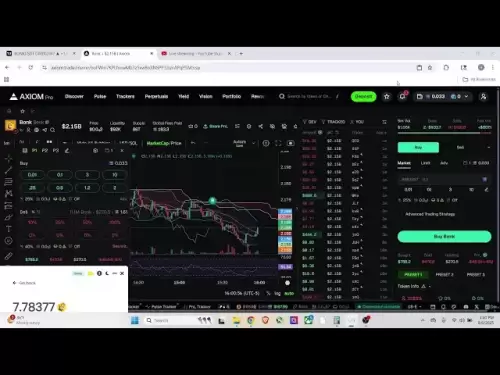-
 Bitcoin
Bitcoin $115100
1.27% -
 Ethereum
Ethereum $3675
2.71% -
 XRP
XRP $2.995
1.45% -
 Tether USDt
Tether USDt $1.000
0.02% -
 BNB
BNB $769.8
2.64% -
 Solana
Solana $168.0
3.25% -
 USDC
USDC $0.9999
-0.01% -
 TRON
TRON $0.3371
1.48% -
 Dogecoin
Dogecoin $0.2051
3.36% -
 Cardano
Cardano $0.7394
2.30% -
 Hyperliquid
Hyperliquid $38.15
0.42% -
 Stellar
Stellar $0.3966
-0.36% -
 Sui
Sui $3.486
2.93% -
 Chainlink
Chainlink $16.72
2.52% -
 Bitcoin Cash
Bitcoin Cash $568.0
4.36% -
 Hedera
Hedera $0.2440
2.59% -
 Ethena USDe
Ethena USDe $1.001
0.04% -
 Avalanche
Avalanche $22.16
2.06% -
 Litecoin
Litecoin $119.1
-0.73% -
 UNUS SED LEO
UNUS SED LEO $8.991
0.04% -
 Toncoin
Toncoin $3.232
-0.39% -
 Shiba Inu
Shiba Inu $0.00001233
2.82% -
 Uniswap
Uniswap $9.717
2.53% -
 Polkadot
Polkadot $3.664
1.85% -
 Dai
Dai $1.000
0.01% -
 Monero
Monero $281.2
-3.89% -
 Bitget Token
Bitget Token $4.350
1.55% -
 Cronos
Cronos $0.1428
5.07% -
 Pepe
Pepe $0.00001050
3.68% -
 Aave
Aave $262.3
3.54%
How to calculate CoinW leverage fees
To calculate leverage fees on CoinW, multiply the funding rate by the funding fee interval and the position size, then adjust the result for the employed leverage.
Nov 11, 2024 at 09:53 am

How to Calculate CoinW Leverage Fees
Leverage trading involves borrowing funds from a broker to amplify potential profits. When engaging in leverage trading on CoinW, it's crucial to understand how leverage fees are calculated to avoid unexpected expenses that could erode your returns. This comprehensive guide will provide a step-by-step explanation of the calculation process, ensuring you have a clear understanding of the fees associated with leverage trading on CoinW.
Step 1: Determine the Funding Rate
The funding rate is a periodic fee charged to maintain leveraged positions. It is calculated based on the difference between the spot market interest rate and the perpetual contract interest rate. A positive funding rate implies that long positions pay short positions, while a negative funding rate indicates the opposite. Traders can find the current funding rate for each trading pair on the CoinW trading interface.
Step 2: Calculate the Funding Fee Interval
The funding fee is charged at specific intervals, which vary depending on the trading pair. The interval is typically expressed in hours and can be found in the contract specifications section of the CoinW trading interface. For instance, the funding fee interval for BTC/USDT perpetual contracts is 8 hours.
Step 3: Determine the Position Size
The position size represents the notional value of the leveraged position held. It is calculated by multiplying the entry price of the position by the leverage employed. A leverage of 10x, for example, would multiply the position size by a factor of 10. Traders can determine the position size by reviewing their open positions in the CoinW trading account.
Step 4: Calculate the Funding Fee Amount
With the funding rate, funding fee interval, and position size determined, the funding fee amount can be calculated using the following formula:
Funding Fee Amount = Funding Rate x Funding Fee Interval x Position Size
For instance, if the funding rate is 0.01%, the funding fee interval is 8 hours, and the position size is $10,000 with a leverage of 10x, the daily funding fee would be calculated as follows:
Funding Fee Amount = 0.01% x 8 x $10,000 = $0.08
Step 5: Adjust for Leverage
The calculated funding fee amount must be adjusted for the employed leverage. This is because the funding fee is charged on the notional position size rather than the actual capital invested. For instance, a leverage of 10x would multiply the funding fee amount by a factor of 10.
Adjusted Funding Fee Amount = Funding Fee Amount x Leverage
Continuing the previous example, the daily funding fee for a position with 10x leverage would be:
Adjusted Funding Fee Amount = $0.08 x 10 = $0.80
Step 6: Determine the Funding Fee Currency
The funding fee is typically paid in the quote currency of the trading pair. For instance, if the trading pair is BTC/USDT, the funding fee would be paid in USDT. Traders can confirm the funding fee currency in the contract specifications section of the CoinW trading interface.
Step 7: Monitor and Manage Fees
Leverage fees can accumulate over time, especially for positions held over extended periods. It's essential to monitor the funding rate and adjust positions accordingly to minimize the impact of fees on profitability. Traders can use tools such as the CoinW trading interface to track funding rates and manage their positions effectively.
Disclaimer:info@kdj.com
The information provided is not trading advice. kdj.com does not assume any responsibility for any investments made based on the information provided in this article. Cryptocurrencies are highly volatile and it is highly recommended that you invest with caution after thorough research!
If you believe that the content used on this website infringes your copyright, please contact us immediately (info@kdj.com) and we will delete it promptly.
- BlockDAG, Litecoin, and Cardano: Charting the Course in Crypto's Dynamic Waters
- 2025-08-07 09:09:06
- Fireverse Token: Igniting a Musical Revolution in Web3
- 2025-08-07 08:27:45
- Ethereum, L2 Withdrawals, and Decentralization: A New Yorker's Take
- 2025-08-07 08:32:33
- Avalanche vs. Ruvi AI: Daily Sales Tell a Story of Crypto Disruption
- 2025-08-07 06:29:35
- DeSoc: The Crypto to Buy Now for a Decentralized Future (and Maybe 43x Gains!)
- 2025-08-07 06:50:16
- Arctic Pablo Coin: Riding the Meme Coin Wave with a Deflationary Twist
- 2025-08-07 07:18:13
Related knowledge

Why is my Bitstamp futures position being liquidated?
Jul 23,2025 at 11:08am
Understanding Futures Liquidation on BitstampFutures trading on Bitstamp involves borrowing funds to open leveraged positions, which amplifies both po...

How to report Bitstamp futures for taxes?
Jul 30,2025 at 08:35am
Understanding Bitstamp Futures and Taxable EventsWhen trading Bitstamp futures, it’s essential to recognize that these financial instruments are treat...

Does Bitstamp offer inverse contracts?
Jul 23,2025 at 01:28pm
Understanding Inverse Contracts in Cryptocurrency TradingIn the realm of cryptocurrency derivatives, inverse contracts are a specific type of futures ...

What is the difference between futures and perpetuals on Bitstamp?
Jul 27,2025 at 05:08am
Understanding Futures Contracts on BitstampFutures contracts on Bitstamp are financial derivatives that allow traders to speculate on the future price...

How to find your Bitstamp futures trade history?
Jul 23,2025 at 08:07am
Understanding Bitstamp and Futures Trading AvailabilityAs of the current state of Bitstamp’s service offerings, it is critical to clarify that Bitstam...

Can I use a trailing stop on Bitstamp futures?
Jul 23,2025 at 01:42pm
Understanding Trailing Stops in Cryptocurrency TradingA trailing stop is a dynamic type of stop-loss order that adjusts automatically as the price of ...

Why is my Bitstamp futures position being liquidated?
Jul 23,2025 at 11:08am
Understanding Futures Liquidation on BitstampFutures trading on Bitstamp involves borrowing funds to open leveraged positions, which amplifies both po...

How to report Bitstamp futures for taxes?
Jul 30,2025 at 08:35am
Understanding Bitstamp Futures and Taxable EventsWhen trading Bitstamp futures, it’s essential to recognize that these financial instruments are treat...

Does Bitstamp offer inverse contracts?
Jul 23,2025 at 01:28pm
Understanding Inverse Contracts in Cryptocurrency TradingIn the realm of cryptocurrency derivatives, inverse contracts are a specific type of futures ...

What is the difference between futures and perpetuals on Bitstamp?
Jul 27,2025 at 05:08am
Understanding Futures Contracts on BitstampFutures contracts on Bitstamp are financial derivatives that allow traders to speculate on the future price...

How to find your Bitstamp futures trade history?
Jul 23,2025 at 08:07am
Understanding Bitstamp and Futures Trading AvailabilityAs of the current state of Bitstamp’s service offerings, it is critical to clarify that Bitstam...

Can I use a trailing stop on Bitstamp futures?
Jul 23,2025 at 01:42pm
Understanding Trailing Stops in Cryptocurrency TradingA trailing stop is a dynamic type of stop-loss order that adjusts automatically as the price of ...
See all articles

























































































